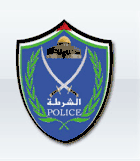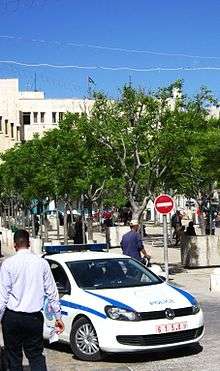Palestinian Civil Police Force
The Palestinian Civil Police Force (Arabic: الشرطة المدنية الفلسطينية, al-Shurtah al-Madaniyah al-Filistiniyah) is the Civil Police organization tasked with traditional law enforcement duties in the autonomous territory governed by the Palestinian National Authority. The Civil Police is a part of the Palestinian Security Services.
| Palestinian Civil Police Arabic:الشرطة المدنية الفلسطينية, al-Shurtah al-Madaniyah al-Filistiniyah | |
|---|---|
 | |
| Jurisdictional structure | |
| National agency | Palestinian Authority |
| Operations jurisdiction | Palestinian Authority |
| Governing body | Palestinian Security Services |
| General nature | |
| Website | |
| http://www.palpolice.ps/en/ | |
.jpg)
History

The Civil Police was formally established with the May 1994 signing of the Gaza–Jericho Agreement, a chapter in the Oslo Accords process, under the umbrella of the General Security Service. Founded with over 10,000 officers, it was the largest substituent of the Palestinian National Security Forces.[1] The agreement called for the civil police maintaining public order from 25 stations throughout the Palestinian-administered parts of the Gaza Strip and the West Bank.[2]
Long-time Police head Ghazi al-Jabali was criticised for corruption and curbing press and civil rights freedoms. In 2004 he was kidnapped by the Jenin Martyrs Brigades, part of the Popular Resistance Committees, and only released after Palestinian President Yasser Arafat agreed to fire him. Al-Jabali was replaced with Arafat's cousin, Musa Arafat, a move which did little to restore public confidence in Police.[1][3]
According to the International Crisis Group, Palestinian police and security forces succeeded in effectively "preventing, prosecuting and reducing crime" in the late 1990s.
During the course of the Second Intifada and its armed conflict, Palestinian police were unable to patrol armed or in uniform, lest they be engaged by Israeli security forces as combatants. As the armed conflict petered out after three years, Palestinian police forces returned to regular operations in 2003-2004.[4]
Development
In order to aid the Palestinian government in "establishing sustainable and effective civil policing arrangements", the European Union Co-ordinating Office for Palestinian Police Support, EUPOLCOPPS, was established beginning 2006.
The Palestinian Civil Police development includes creation of a Jericho Police Training School,[5] and strengthening of investigative sectors like Crime Investigation Department, Anti-Narcotics General Administration, and Investigation Section.[6]
The EUCOPPS mission has facilitated the training of Civil Police personnel as well as the donation of equipment including vehicles from European donor-states.[7][8]
A Palestinian Local Aid Coordination Secretariat strategic report on the Civil Police lists among the force's strengths its leadership's youth and academic credentials, high loyalty and commitment to regulations and motivation, while weaknesses included poorly or undefined legal frameworks and logistical shortages, especially communications equipment and transportation.[9]
Since 2007, the Palestinian Civil Police and the Israel Police have increased cooperation as confidence-building measures and a part of Palestinian institution-building. Since their jurisdictions are intertwined, cooperative tactics include having Israel police issue traffic citations to Palestinian drivers and repatriating the proceeds to the Palestinian Civil Police.[10]
Attacks by Palestinian Police officers
- Sep 29, 2000 - Israeli police Inspector Yossi Tabaja, 27, was murdered by his Palestinian colleague while on an Oslo Accord-stipulated joint patrol.[11]
- The 2010 Tapuah Junction stabbing was carried out by Muhammad Hatib, a long-serving Palestinian police officer, and chief of Police in Ramallah at the time of the attack.[12]
See also
- United States security assistance to the Palestinian Authority
- Common Security and Defence Policy
- European Union Police Mission for the Palestinian Territories
References
| Wikimedia Commons has media related to Police of Palestine. |
- Civil Police (al-Shurta Madaniyya) GlobalSecurity.org
- Main Points of the Israeli-Palestinian Interim Agreement on the West Bank and the Gaza Strip Israeli Ministry of Foreign Affairs
- Arafat appoints West Bank and Gaza Strip police chief - Al-Jazeera.
- Who Governs the West Bank? Palestinian Administration under Israeli Occupation Archived 2011-09-04 at the Wayback Machine International Crisis Group
- افتتاح دورة متقدمة في الحاسوب في كلية الشرطة في أريحا
- Police Advisory Section European Union Co-ordinating Office for Palestinian Police Support
- Belgium donates 25 cars to Palestinian Civil Police
- "Training Prosecutors and Palestinian Civil Police Officers in Germany through Eupol Copps". Archived from the original on 2016-03-04. Retrieved 2012-02-26.
- Palestinian Civil Police Strategic Framework Local Aid Coordination Secretariat
- Growing ties between Israeli, PA police forces. The Jerusalem Post, 10 September 2009
- https://www.washingtontimes.com/news/2000/oct/4/20001004-012115-8527r/
- Issacharoff, Avi (11 February 2010). "Soldier From Elite Unit Fatally Stabbed by Palestinian Police Officer in W. Bank". Haaretz. Retrieved 24 July 2017.